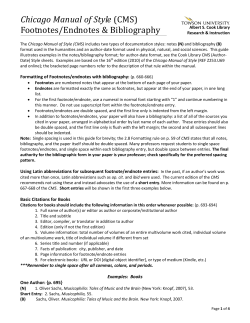
Referencing – Footnote style In-text referencing
Referencing – Footnote style In-text referencing There are many variations of the footnoting system. Always follow information given to you by your lecturer. Here are some guidelines: The easiest way to format your footnotes is to use the Microsoft Word referencing tool. (Insert> reference> footnote). If you are not using this application use a superscript—1. Then type the corresponding number at the bottom of the page, citing all the bibliographic information. The first time a source is cited include the author's full name, the title of the work and publication details (see examples below). Subsequent references to the same work can usually be in a shortened form (but check with your lecturer first about suitable abbreviations). Include page numbers at the end of the footnote only when quoting, not when you paraphrase. • • • Example In the text Advertisers are very good at ‘putting the hype into hyperbole’, unfortunately often resulting in a sceptical audience.1 Geddes argues that in order to create advertising impact, there needs to be a continually fresh approach 2, and although others point to the impossibility of this 3, a recent study showed that audiences subjected to bland advertising had difficulty in remembering the product.4 The footnotes 1. 2. 3. 4. Jeffrey McQuain, Power language, Houghton Mifflin Company, Boston, 1996, p.53. Miranda Geddes, The advertiser’s toolbag, Hudson, Perth, 2003. Peter Henders, Design issues, Chesley Publishing, London, 2001, ; June Sapforth, 1999, The importance of design, Howarth Press, New York. Geddes, loc. cit. The Latin abbreviation loc. cit. has been used to indicate that the source has already been mentioned. Abbreviation: Use: Example: ibid. (in the same place) To indicate the same source as in the footnote immediately above. If referring to a different page number write ibid p.35. 1. loc.cit. (in the place already quoted) To indicate a source and page number already cited, but one not immediately above. 2. 3. 1. 2. 3. op.cit. (in the work cited) To indicate a different page number of a source already cited, but one not immediately above. 1. 2. 3. Learning Links Quick Tips/footnotes Jane Clayden, Design notes, Tegdale Press, London, 2000, p.281. ibid ibid, p.39. Jane Clayden, Design notes, Tegdale Press, London, 2000, p.281. Andrea Jones, A history of art, Blum Press, New York, 1999, p. 38. Clayden, loc.cit. Jane Clayden, Design notes, Tegdale Press, London, 2000, p.281. George Thompson, Modern design, Noble Press, New York, 1999, p. 38. Clayden, op.cit., p. 270. www.rmit.edu.au/studyandlearningcentre/ February 2007 Examples of footnotes Book – one author Dunstan, Ewen, Sources of ideas, Sun Press, Boston, 2004, p. 71-78. Book – multiple authors Raphael, Gerald, Brown Colin and Stewart, Ann, Design ideas Harris, New York, 1998. Chapter in a book by another author Jane, Thompson, Women’s art. Chap. in Art in the 1990’s, eds. Privet, James, and Martin, Peter, Maundie Press, New York, 2003. Article in Journal Gerald, King, Design speaks, Signs and symbols, vol. 5, no.1, 1998, p. 25-30. Published conference proceedings Erin, Carter, and Packer, K, eds, Selected Proceedings of the 2nd Annual Conference on Art Studies, University of Westland, Westland, 1999, p. 139-150. Internet citation Iris, Heetman, Early design development, Waters Research Centre, 2004, http://www.wester.com, Viewed 15 June, 2004. Examples of Reference List items Book – one author Dunstan Eric, 2004, Sources creativity, Styles Press, Sydney. Book – multiple authors Raphael, Georgina, Beaton, Carol and Homes, Stuart, 2003, Art studies, Hartnell, New York. Chapter in a book by another author Thompson, Brenda, Women’s work. Chap. in Women and art , eds. Pinder D.L, and Martin, E, 1997, Mainstream Press, New York. Article in Journal King, Gerry, 1998, Design matters, Design Quarterly, vol. 5, no.1. Published conference proceedings Carter, Eric, and Packer, Terry, eds, 1997, Selected Proceedings of the 2nd Annual Conference on Art Studies, University of Westland, Westland. Internet citation Harvey, Thomas, 1995, Early fabrics, Somer Research Centre, 2004, http://www.somer.com, Viewed 15 June. Learning Links Quick Tips/footnotes www.rmit.edu.au/studyandlearningcentre/ February 2007
© Copyright 2025





















